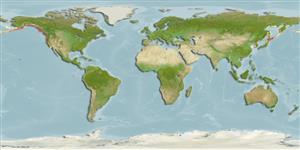>
Perciformes/Zoarcoidei (Eelpouts and pricklebacks) >
Scytalinidae (Graveldivers)
Etymology: Scytalina: Greek, skytale, -es = branch; cylindrical piece of wood used by Spartan army, with a paper tied around it containing orders or comunnications from the courts. It is also a kind of fish (Ref. 45335).
More on authors: Jordan & Gilbert.
Environment: milieu / climate zone / depth range / distribution range
Ecología
marino demersal. Temperate
Eastern Pacific: Bering Sea coast of Alaska to Diablo Cove, central California, USA.
Tamaño / Peso / Age
Maturity: Lm ? range ? - ? cm
Max length : 15.0 cm TL macho / no sexado; (Ref. 2850)
Espinas dorsales (total): 0; Radios blandos dorsales (total): 41-51; Espinas anales 0; Radios blandos anales: 36 - 41. Caudal rounded. Pectorals small.
Found in rocky areas, tide pools and off beaches (Ref. 2850). Burrows in loose gravel and sand or among broken shells on the bottom (Ref. 2850). May not utilize the intertidal zone for reproductive and recruitment purposes (Ref. 56899).
Life cycle and mating behavior
Madurez | Reproducción | Puesta | Huevos | Fecundidad | Larva
Eschmeyer, W.N., E.S. Herald and H. Hammann, 1983. A field guide to Pacific coast fishes of North America. Boston (MA, USA): Houghton Mifflin Company. xii+336 p. (Ref. 2850)
IUCN Red List Status (Ref. 130435)
Threat to humans
Harmless
Human uses
Más información
Nombres comunesSinónimosMetabolismoDespredadoresEcotoxicologíaReproducciónMadurezPuestaAgregación para la puestaFecundidadHuevosEgg development
Age/SizeCrecimientoLength-weightLength-lengthLength-frequenciesMorfometríaMorfologíaLarvaDinámica larvariaReclutamientoAbundanciaBRUVS
ReferenciasAcuiculturaPerfil de acuiculturaRazasGenéticaElectrophoresesheritabilidadEnfermedadesProcesamientoNutrientsMass conversion
ColaboradoresImágenesStamps, Coins Misc.SonidosCiguateraVelocidadTipo de nataciónSuperficie branquialOtolitosCerebrosVisión
Herramientas
Special reports
Download XML
Fuentes de Internet
Estimates based on models
Preferred temperature (Ref.
123201): 5.7 - 14.8, mean 9.8 °C (based on 220 cells).
Phylogenetic diversity index (Ref.
82804): PD
50 = 1.5000 [Uniqueness, from 0.5 = low to 2.0 = high].
Bayesian length-weight: a=0.00389 (0.00180 - 0.00842), b=3.12 (2.94 - 3.30), in cm total length, based on all LWR estimates for this body shape (Ref.
93245).
Nivel trófico (Ref.
69278): 3.3 ±0.5 se; based on diet studies.
Fishing Vulnerability (Ref.
59153): Low vulnerability (10 of 100).
